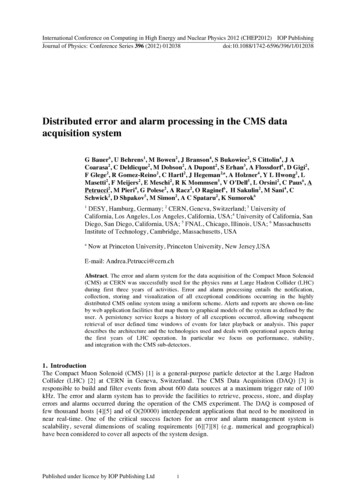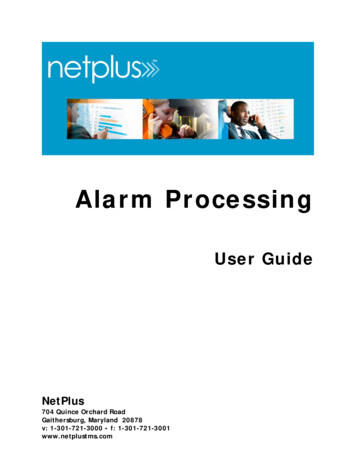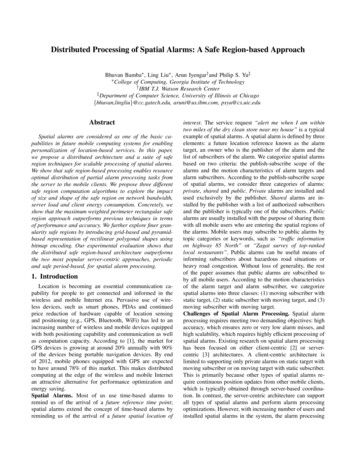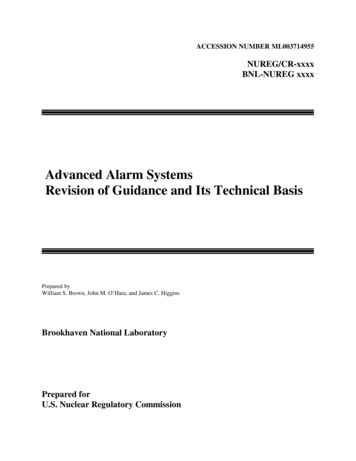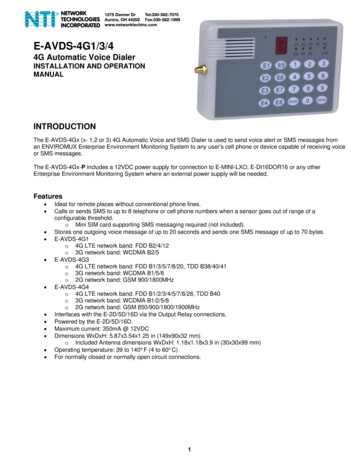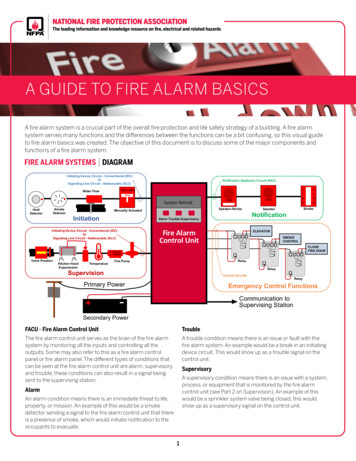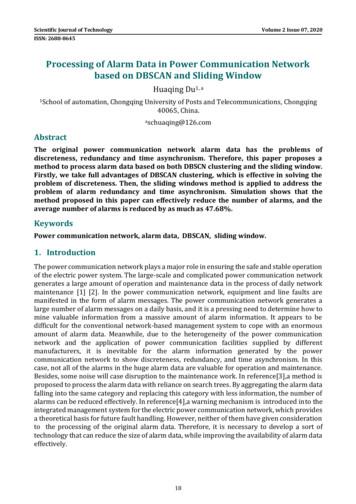
Transcription
Scientific Journal of TechnologyVolume 2 Issue 07, 2020ISSN: 2688-8645Processing of Alarm Data in Power Communication Networkbased on DBSCAN and Sliding WindowHuaqing Du1, a1Schoolof automation, Chongqing University of Posts and Telecommunications, Chongqing40065, China.aschuaqing@126.comAbstractThe original power communication network alarm data has the problems ofdiscreteness, redundancy and time asynchronism. Therefore, this paper proposes amethod to process alarm data based on both DBSCN clustering and the sliding window.Firstly, we take full advantages of DBSCAN clustering, which is effective in solving theproblem of discreteness. Then, the sliding windows method is applied to address theproblem of alarm redundancy and time asynchronism. Simulation shows that themethod proposed in this paper can effectively reduce the number of alarms, and theaverage number of alarms is reduced by as much as 47.68%.KeywordsPower communication network, alarm data, DBSCAN, sliding window.1. IntroductionThe power communication network plays a major role in ensuring the safe and stable operationof the electric power system. The large-scale and complicated power communication networkgenerates a large amount of operation and maintenance data in the process of daily networkmaintenance [1] [2]. In the power communication network, equipment and line faults aremanifested in the form of alarm messages. The power communication network generates alarge number of alarm messages on a daily basis, and it is a pressing need to determine how tomine valuable information from a massive amount of alarm information. It appears to bedifficult for the conventional network-based management system to cope with an enormousamount of alarm data. Meanwhile, due to the heterogeneity of the power communicationnetwork and the application of power communication facilities supplied by differentmanufacturers, it is inevitable for the alarm information generated by the powercommunication network to show discreteness, redundancy, and time asynchronism. In thiscase, not all of the alarms in the huge alarm data are valuable for operation and maintenance.Besides, some noise will case disruption to the maintenance work. In reference[3],a method isproposed to process the alarm data with reliance on search trees. By aggregating the alarm datafalling into the same category and replacing this category with less information, the number ofalarms can be reduced effectively. In reference[4],a warning mechanism is introduced into theintegrated management system for the electric power communication network, which providesa theoretical basis for future fault handling. However, neither of them have given considerationto the processing of the original alarm data. Therefore, it is necessary to develop a sort oftechnology that can reduce the size of alarm data, while improving the availability of alarm dataeffectively.18
Scientific Journal of TechnologyVolume 2 Issue 07, 2020ISSN: 2688-86452. Alarm Data Processing of Power Communication Network based onDBSCAN and Sliding Window2.1.Alarm Data Processing of Power Communication Network based onDBSCANBased on density clustering,Ester proposed DBSCAN algorithm[5][6],which can automaticallydetermine the number of clusters, and has two parameters, including the clustering radius Epsand the minimum density threshold MinPts, The clustering radius Eps determines the size ofthe cluster, and the MinPts determines whether the randomly selected object P is the coreobject. When the DBSCAN clustering algorithm is applied to process the original alarm data ofthe power communication network, it is sufficient to input the original alarm data set D, theclustering radius Eps, and the minimum density threshold MinPts, as the cluster analysis canbe completed automatically. The clustering approach involves two parts: One is the clusterdiscovery and the other is neighborhood expansion. The process of DBSCAN is illustrated inFigure 1:Figure 1. DBSCAN algorithm execution process2.2.Alarm Data Processing of Power Communication Network based on SlidingWindowSliding windows have a widespread applications in the processing of time-based streams[7][8],while power communications network alarms data are typically time-series data. The slidingwindow contains two parameters, which are the sliding window size W and sliding step S. Asshown in Figure 2,A to F are different alarm transactions, the sliding window is 5 and slidingstep is 2.After sliding widow process we can obtain the following data {(ABC) (CBD) (BCDE)(DBEF) (EF) }. Compared with the original data, there are no duplicate alarm transaction itemsin each window, as a result of which alarm transactions redundancy is eliminated.19
Scientific Journal of TechnologyVolume 2 Issue 07, 2020ISSN: 2688-8645Figure 2. Example of sliding window2.3.Alarm Data Processing of Power Communication Network based onDBSCAN and Sliding WindowAs for such problems as discreteness and redundancy encounter by the original power alarmdata, we choose to combine clustering and sliding window, and proposed the processing ofpower alarm data processing based on clustering and sliding window. The main steps as follows:Step1: In order to address the problem of discrete of raw alarm information, we choose theDBSCAN clustering algorithm to cluster the time period of the alarm information. Which ispurposed to find the alarm-intensive time periods, and to remove the scattered alarminformation.Step2: After clustering, we take the sliding window approach to process the clustered alarmdata. Base on the principle that" alarm data appears in the same window are regarded asoccurring at the same time, and the same alarm information recorded only once" alarm dataredundancy is eliminated and time asynchronism is resolved. The realization process of themethod is illustrated in Figure 3:Figure 3. The operation process of proposed method20
Scientific Journal of TechnologyVolume 2 Issue 07, 2020ISSN: 2688-86453. Experimental and SimulationIn order to demonstrate the advantage of the method proposed in this paper in the processingof power communication network alarm data, we select three groups of power communicationnetwork alarm data on a random basis, and apply the method proposed in this paper, slidingwindow and clustering to deal with the alarm data. Finally, we compare the number of alarmsproduced using the three methods. Table 1 lists the alarm numbers of the selected alarm data.Number of groups123Table 1. Selected alarm dataNumber of alarm transactions165105126The third-party module in machine learning Scikit-learn (sklearn) can easily and efficientlyachieve cluster analysis[9][10]. Our technical route is to achieve cluster analysis by callingSklean.cluster.DBSCAN. Before calling this function, we must initialize parameters of theDBSCAN clustering algorithm. The parameters are initialized as follows:DBSCAN(eps 8,min samples 10,metric ’euclidean’,metric params None,algorithm ‘auto’,leaf size 30,p None,n jobs None).In python, sliding window analysis can be achieved by calling the rolling function in the pandasmodule. At the same time, the two parameters of the sliding window are 8 and 2. Theexperimental results are shown below. Among them, Figure 4 is the result of processing theoriginal power communication network alarm data using the clustering and sliding window(DBSW)method proposed in this paper, Figure 5 is the result of using DBSCAN clusteringalgorithm (DB), and Figure 6 is the result of using the sliding window (SW), and Figure 7 is thecomparison of the results of the three approaches. From Figure 7, we can see that the methodproposed in this paper has distinct advantages in processing the raw power alarm data.Figure 4. Using DBSW to cope with alarm data21
Scientific Journal of TechnologyVolume 2 Issue 07, 2020ISSN: 2688-8645Figure 5. Using DBSCAN only to cope with alarm dataFigure 6. Using SW only to cope with alarm dataFigure 7. Comparison of the three methods22
Scientific Journal of TechnologyVolume 2 Issue 07, 2020ISSN: 2688-8645In order to further demonstrate that the method proposed in this paper is effective in reducingthe number of alarms. Table 2 indicates the number of remaining alarms in each group of rawalarm data after processing by three methods.Table 2. Comparison of three methodsThree kinds of methodsDBSWDBSWGroup oneBefore After16589165124165109Group twoBefore After105641057210589Group threeBefore After126531269212678Average decrease (%)47.6827.1029.81From Table 2, it can be seen that after a combination of clustering and sliding windows toprocess the alarm data of power communication network, the comparison made with the othertwo methods reveals that the average number of alarms is reduced by as much as 47.68%,which evidences the effectiveness of the proposed method in reducing the number of alarms inthe power communication network and in improving the availability of alarm data for thepower communication network.4. ConclusionIn order to resolve various problems with the alarm data in the power communication network,This paper proposes a method that combines clustering and sliding windows. Firstly, theproblem of discrete alarm in power communication network is solved by clustering, and thensliding window is used to solve the problems of redundancy and time asynchronous in thepower communication network alarm data. Finally, the superiority of the method proposed inthis paper when processing the alarm data of electric power communication network is verifiedby experiments.References[1] X. Miao, J. Li and X. Chen, "Research on reliability assessment method of electric powercommunication network and application," 2012 China International Conference on ElectricityDistribution, Shanghai, 2012, pp. 1-3.[2] X. Zhang et al., "Architecture Design of Electric Power Emergency Communication Based on 4G LTENetwork," 2019 IEEE 4th International Conference on Cloud Computing and Big Data Analysis(ICCCBDA), Chengdu, China, 2019, pp. 600-603.[3] Wang Baoyi, Guo Yawei, Shi Zhancheng, Zhang Shaomin. Research of alarm correlation methodbased on dependency search tree in electric power communication network[J]. Realy,2008(06):5964.[4] Li LiDa. Design and Realization of fault alarm mechanism in network management system of powercommunications network[J]. Telecommunications for electric power system,2006(12):13-16.[5] A. Smiti and Z. Elouedi, "DBSCAN-GM: An improved clustering method based on Gaussian Meansand DBSCAN techniques," 2012 IEEE 16th International Conference on Intelligent EngineeringSystems (INES), Lisbon, 2012, pp. 573-578.[6] Huan Yu and Wenhui Zhang, "DBSCAN data clustering algorithm for video stabilizing system,"Proceedings 2013 International Conference on Mechatronic Sciences, Electric Engineering andComputer (MEC), Shengyang, 2013, pp. 1297-1301.[7] Wang Dewen, Yang Liping. Streaming processing method and condition monitoring anomalydetection of smart grid big data [J]. Automation of Electric Power Systems, 2016, 40 (14): 122-128.23
Scientific Journal of TechnologyVolume 2 Issue 07, 2020ISSN: 2688-8645[8] Li Guohui, Chen Hui. Mining frequent patterns in an arbitrary sliding time window of a data stream[J]. Journal of Software, 2008 (10): 2585-2596.[9] Information on .html#dbscan .[10] Huang YongChang. Machine learning by scikit-learn: Algorithms and Practices[M]. Beijing: ChinaMachine Press, 2018.24
2.3. Alarm Data Processing of Power Communication Network based on DBSCAN and Sliding Window As for such problems as discreteness and redundancy encounter by the original power alarm data, we choose to combine clustering and sliding window, and proposed the processing of power alarm data processing based on clustering and sliding window.

